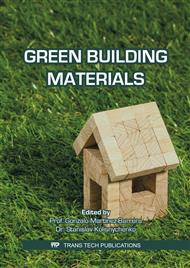[1]
M.U. Qureshi, I. Chang, K. Al-Sadarani, Strength and durability characteristics of biopolymer-treated desert sand, Geomechanics and Engineering. 12 (2017). https://doi.org/10.12989/gae.2017.12.5.785.
DOI: 10.12989/gae.2017.12.5.785
Google Scholar
[2]
M. Cubrinovski, K. Ishihara, Maximum and minimum void ratio characteristics of sands, Soils and Foundations. 42 (2002) 65–78. https://doi.org/10.3208/sandf.42.6_65.
DOI: 10.3208/sandf.42.6_65
Google Scholar
[3]
M.U. Qureshi, B. Al-Sawafi, M. Al-Washahi, M. Al-Saidi, S. Al-Badi, The Sustainable Use of Fine Marble Waste Powder for the Stabilization of Desert Sand in Oman, in: Springer, Cham, 2018: p.303–313. https://doi.org/10.1007/978-3-319-61612-4_25.
DOI: 10.1007/978-3-319-61612-4_25
Google Scholar
[4]
Y.E.A. Mohamedzein, M.Y. Al-Aghbari, The Use of Municipal Solid Waste Incinerator Ash to Stabilize Dune Sands, Geotechnical and Geological Engineering. 30 (2012) 1335–1344. https://doi.org/10.1007/s10706-012-9548-8.
DOI: 10.1007/s10706-012-9548-8
Google Scholar
[5]
M.Y. Al-Aghbari, Y.E.-A. Mohamedzein, R. Taha, Stabilisation of desert sands using cement and cement dust, Proceedings of the Institution of Civil Engineers - Ground Improvement. 162 (2009) 145–151. https://doi.org/10.1680/grim.2009.162.3.145.
DOI: 10.1680/grim.2009.162.3.145
Google Scholar
[6]
I. Chang, M. Lee, A.T.P. Tran, S. Lee, Y.M. Kwon, J. Im, G.C. Cho, Review on biopolymer-based soil treatment (BPST) technology in geotechnical engineering practices, Transportation Geotechnics. 24 (2020) 100385. https://doi.org/10.1016/j.trgeo.2020.100385.
DOI: 10.1016/j.trgeo.2020.100385
Google Scholar
[7]
C.M. Shillaber, J.K. Mitchell, J.E. Dove, Energy and Carbon Assessment of Ground Improvement Works. II: Working Model and Example, Journal of Geotechnical and Geoenvironmental Engineering. 142 (2016) 04015084. https://doi.org/10.1061/(asce)gt.1943-5606.0001411.
DOI: 10.1061/(asce)gt.1943-5606.0001411
Google Scholar
[8]
N. Bilgin, H.A. Yeprem, S. Arslan, A. Bilgin, E. Günay, M. Maroglu, Use of waste marble powder in brick industry, Construction and Building Materials. 29 (2012) 449–457. https://doi.org/10.1016/j.conbuildmat.2011.10.011.
DOI: 10.1016/j.conbuildmat.2011.10.011
Google Scholar
[9]
O. Sivrikaya, K.R. Kiyildi, Z. Karaca, Recycling waste from natural stone processing plants to stabilise clayey soil, Environmental Earth Sciences. 71 (2014) 4397–4407. https://doi.org/10.1007/s12665-013-2833-x.
DOI: 10.1007/s12665-013-2833-x
Google Scholar
[10]
H. Luodes, P.M. Kauppila, N. Luodes, S. Aatos, J. Kallioinen, S. Luukkanen, J. Aalto, Characteristics and the environmental acceptability of the natural stone quarrying waste rocks, Bulletin of Engineering Geology and the Environment. 71 (2012) 257–261. https://doi.org/10.1007/s10064-011-0398-z.
DOI: 10.1007/s10064-011-0398-z
Google Scholar
[11]
T.A. Adongo, N. Kyei-Baffour, F.K. Abagale, W.A. Agyare, Assessment of reservoir sedimentation of irrigation dams in northern Ghana, Lake and Reservoir Management. 36 (2020) 87–105. https://doi.org/10.1080/10402381.2019.1659461.
DOI: 10.1080/10402381.2019.1659461
Google Scholar
[12]
P. Studds, Z.M. Miller, Sustainable material reuse solutions for dredged sediments, International Journal of Sustainable Engineering. 3 (2010) 33–39. https://doi.org/10.1080/19397030903380960.
DOI: 10.1080/19397030903380960
Google Scholar
[13]
K. Deb, V.A. Sawant, A.S. Kiran, Effects of fines on compaction characteristics of poorly graded sands, International Journal of Geotechnical Engineering. 4 (2010) 299–304. https://doi.org/10.3328/IJGE.2010.04.02.299-304.
DOI: 10.3328/ijge.2010.04.02.299-304
Google Scholar
[14]
M.Y. Al-Aghbari, Y.E.-A. Mohamedzein, R. Taha, Stabilisation of desert sands using cement and cement dust, Proceedings of the Institution of Civil Engineers - Ground Improvement. 162 (2009) 145–151. https://doi.org/10.1680/grim.2009.162.3.145.
DOI: 10.1680/grim.2009.162.3.145
Google Scholar
[15]
D.L. O'Sadnick, B.E. Simpson, G.K. Kasel, Evaluation and performance of a sand/bentonite liner, in: Geoenvironment 2000@ SCharacterization, Containment, Remediation, and Performance in Environmental Geotechnics, American Society of Civil Engineers, New York, NY, 1995: p.688–701.
Google Scholar
[16]
M.U. Qureshi, I. Chang, K. Al-Sadarani, Strength and durability characteristics of biopolymer-treated desert sand, Geomechanics and Engineering. 12 (2017) 785–801. https://doi.org/10.12989/gae.2017.12.5.785.
DOI: 10.12989/gae.2017.12.5.785
Google Scholar
[17]
M.U. Qureshi, A. Al-Hilly, O. Al-Zeidi, A. Al-Barrami, A. Al-Jabri, Vane shear strength of bio-improved sand reinforced with natural fibre, in: E3S Web of Conferences, 2019. https://doi.org/10.1051/e3sconf/20199212004.
DOI: 10.1051/e3sconf/20199212004
Google Scholar
[18]
M.U. Qureshi, M. Alsaidi, M. Aziz, I. Chang, A.M. Rasool, Z.A. Kazmi, Use of Reservoir Sediments to Improve Engineering Properties of Dune Sand in Oman, Appl Sci. 2021 (2021) 1620. https://doi.org/10.3390/app11041620.
DOI: 10.3390/app11041620
Google Scholar
[19]
N.C. Consoli, M.A. Vendruscolo, A. Fonini, F.D. Rosa, Fiber reinforcement effects on sand considering a wide cementation range, Geotextiles and Geomembranes. 27 (2009) 196–203. https://doi.org/10.1016/j.geotexmem.2008.11.005.
DOI: 10.1016/j.geotexmem.2008.11.005
Google Scholar
[20]
T.W. Park, H.J. Kim, M.T. Tanvir, J.B. Lee, S.G. Moon, Influence of coarse particles on the physical properties and quick undrained shear strength of fine-grained soils, Geomechanics and Engineering. 14 (2018) 99–105. https://doi.org/10.12989/gae.2018.14.1.099.
Google Scholar
[21]
H. Choo, W. Lee, C. Lee, Compressibility and small strain stiffness of kaolin clay mixed with varying amounts of sand, KSCE Journal of Civil Engineering. 21 (2017) 2152–2161. https://doi.org/10.1007/s12205-016-1787-4.
DOI: 10.1007/s12205-016-1787-4
Google Scholar
[22]
P. V. Lade, C.D. Liggio, J.A. Yamamuro, Effects of Non-Plastic Fines on Minimum and Maximum Void Ratios of Sand, Geotechnical Testing Journal. 21 (1998) 336–347. https://doi.org/10.1520/gtj11373j.
DOI: 10.1520/gtj11373j
Google Scholar



